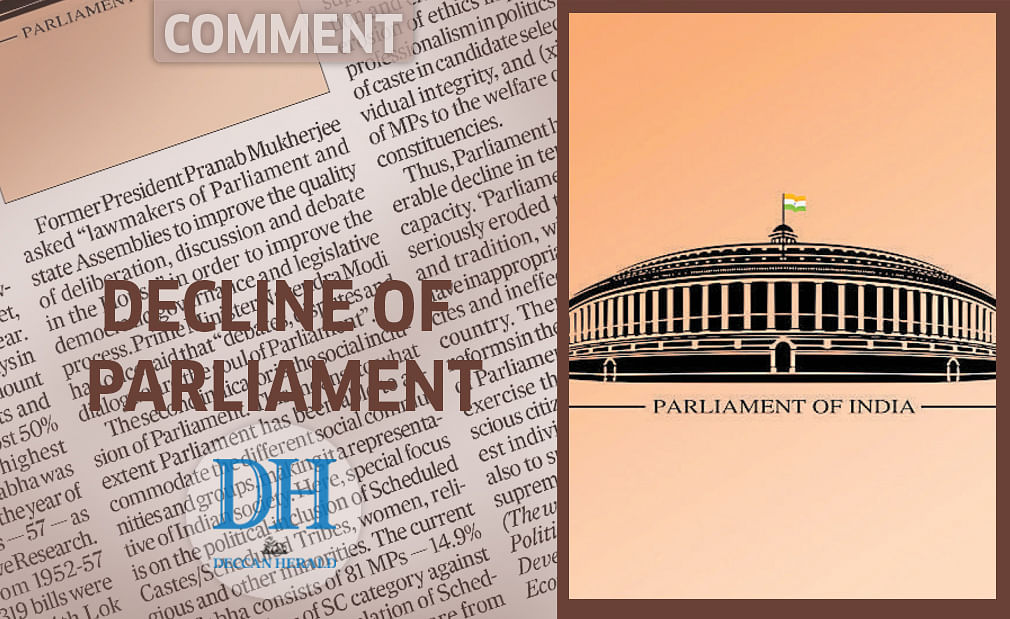India is the world's largest, youngest and the most representative democratic nation. On the eve of our 69th Republic Day, it is necessary to look into the journey and functioning of parliamentary democracy. The stability of functional democracy in India is evident from the 16 continuous and competitive elections to Parliament, separation of powers between the various organs of government, an independent judiciary, federalism and free media.
The citizens of India have shown faith and trust in parliamentary democracy from time to time by participating in the elections. The voter turnout in the last general elections was 66.44%, the highest since 1951. This compares with the voting percentage in the most recent parliamentary elections in the UK (66.12%) and the US (65.44%).
Given this impressive electoral legitimacy of the Parliament, the question that needs to be asked is, to what extent the Parliament has functioned effectively to achieve the goals of justice, equality, liberty and fraternity as enshrined in the preamble of the Constitution. The analysis has been carried out on the basis of three governance indicators - law-making, social inclusion and institutional effectiveness.
In the 1950-60s, Parliament, the law-making organ of the State, used to meet, on an average, 125-130 days in a year. This has come down to just 65-70 days in the last decade. It means that the amount of time for which Parliament sits and deliberates has declined by almost 50% between 1960 and 2010. The highest number of sittings of the Lok Sabha was 151 - in 1956. In fact, 2017 was the year of the lowest number of sittings - 57 - as per the data of PRS Legislative Research.
The first Lok Sabha from 1952-57 had 677 sittings in which 319 bills were passed. In comparison, the 14th Lok Sabha from 2004-2009 had 332 sittings and passed 247 bills; the 15th Lok Sabha had 357 sittings and passed 181 bills; the 16th Lok Sabha has had 226 sittings and passed only 129 bills (up to the 11th session).
A similar trend can be observed in the sittings of Rajya Sabha and the passage of bills. Till 1998, the assurances made by the ministries concerned during the debate in Parliament and its implementation percentage were 100, except in 1995, when it was 99.93%. Then onwards, there has been a mismatch between assurances and implementation. It hit the lowest - 21.94% - in 2015!
The amount of time lost due to interruptions and adjournments have increased from 5.28% during the 11th Lok Sabha to 41.6% during the 15th Lok Sabha. From these facts and figures, it suffices to say that the quality of debate/ discussions in Parliament to enact laws has substantially declined over a period of time.
Former President Pranab Mukherjee asked "lawmakers of Parliament and state Assemblies to improve the quality of deliberation, discussion and debate in the House" in order to improve the democratic governance and legislative process. Prime Minister Narendra Modi had once said that "debates, disputes and dialogue are the soul of Parliament".
The second indicator is the social inclusion of Parliament. This means, to what extent Parliament has been able to accommodate the different social communities and groups, making it a representative of Indian society. Here, special focus is on the political inclusion of Scheduled Castes/Scheduled Tribes, women, religious and other minorities. The current Lok Sabha consists of 81 MPs - 14.9% of its strength - of SC category against 16.6% of the total population of Scheduled Castes; 49 MPs - 9% - are from Scheduled Tribes, against an ST population of 8.6%; 62 women MPs constitute 11.4% of the Lok Sabha, while women constitute 49% of India's population; there are 23 Muslim MPs - 4.2% of Lok Sabha - while the community makes up 10.5% of the country's population.
Overall, the social base of Parliament has expanded, along with the rise of Other Backward Classes, since the 10th Lok Sabha. It is evident that SCs, women and Muslims are under-represented in Parliament, women especially so. However, it must be noted that the increased social base has not resulted in socially sensitive policies from the government.
Criminal representatives
The third indicator is the institutional decay of parliamentary efficacy. As per data from the Association of Democratic Reforms, 186 MPs out of 543 are facing criminal charges in the current Lok Sabha. That is, one in every three of our MPs is charged with criminal cases. The BJP has 282 MPs, and out of these 98 are facing criminal cases. How can we expect accountable and transparent governance from such political representatives? We, as a society, have collectively failed to elect honest candidates who are committed to clean politics and governance.
Other determinants that shape the quality and substance of Parliament are (i) knowledge and wisdom of MPs, (ii) political consciousness, (iii) research support to the MPs, (iv) commercialisation and criminalisation of politics, (v) erosion of ethics in politics, (vi) lack of professionalism in politics, (vii) influence of caste in candidate selection, (viii) individual integrity, and (xi) commitment of MPs to the welfare of people in their constituencies.
Thus, Parliament has shown a considerable decline in terms of institutional capacity. 'Parliamentary paralysis' has seriously eroded the democratic ethos and tradition, with the result that we have inappropriate socio-economic policies and ineffective laws to govern the country. There is an urgent need for reforms in the composition and conduct of Parliament. We, the people, have to exercise the power of active and conscious citizenship, not only to send honest individuals to the Lok Sabha, but also to sustain our democracy and the supremacy of Parliament.
(The writer is Doctoral Fellow, Centre for Political Institutions, Governance and Development, Institute for Social and Economic Change, Bengaluru)
